Abstract
Objective:
To determine the comparative effect of sports massage, active recovery, and rest on promoting blood lactate clearance after maximal anaerobic (supramaximal) leg exercise.
Design and Setting:
A counterbalanced experimental design with repeated measures was used. The repeated measures were the three treatment conditions. The order of the conditions was determined by random assignment to a counterbalanced test sequence. All data were collected in the Human Energy Research Laboratory at the University of Pittsburgh.
Subjects:
Ten male competitive cyclists volunteered for this investigation.
Measurements:
Serial venous blood samples were drawn and analyzed for blood lactate concentration for each test condition.
Results:
There were significant main effects for both absolute and relative values of blood lactate concentration between the three treatment groups and across time within groups.
Conclusions:
After supramaximal leg exercise, active recovery produced significant decreases in both absolute and relative measures of blood lactate concentration when compared with the sports massage and rest conditions. No significant difference was found between sports massage and rest for either absolute or relative changes in blood lactate concentration.
Keywords: anaerobic glycolysis, lactic acid, metabolic acidosis
Full text
PDF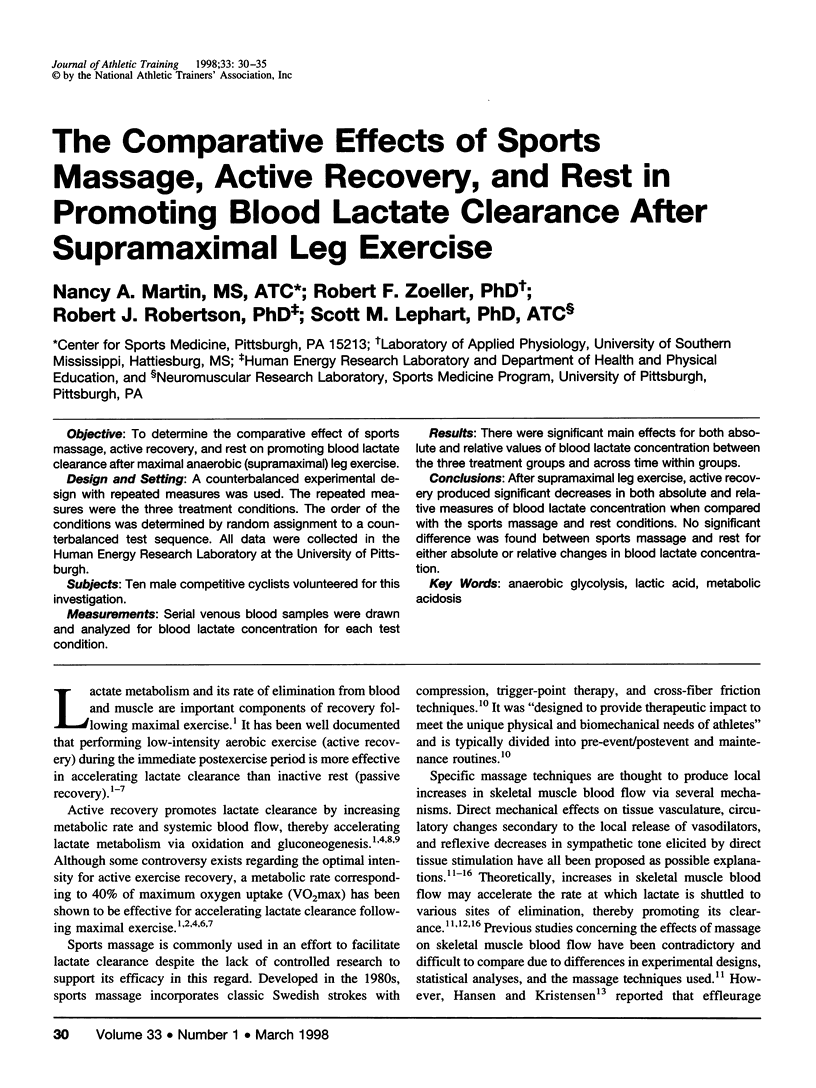
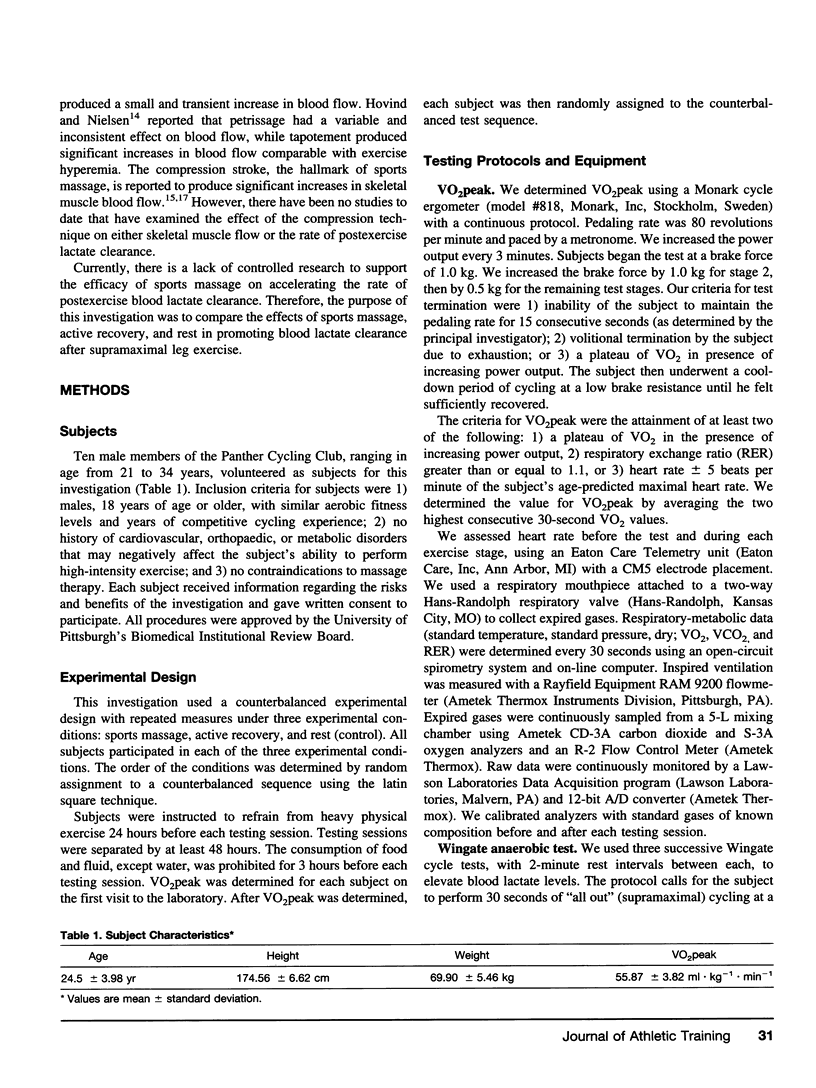
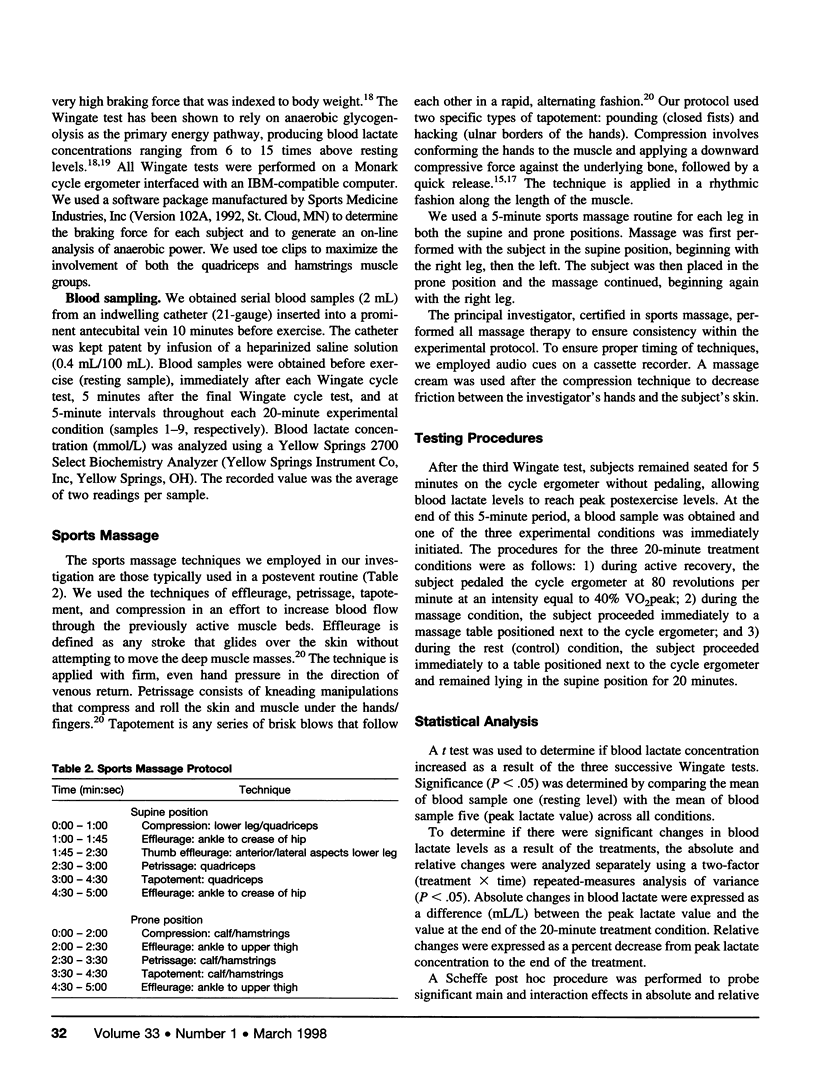
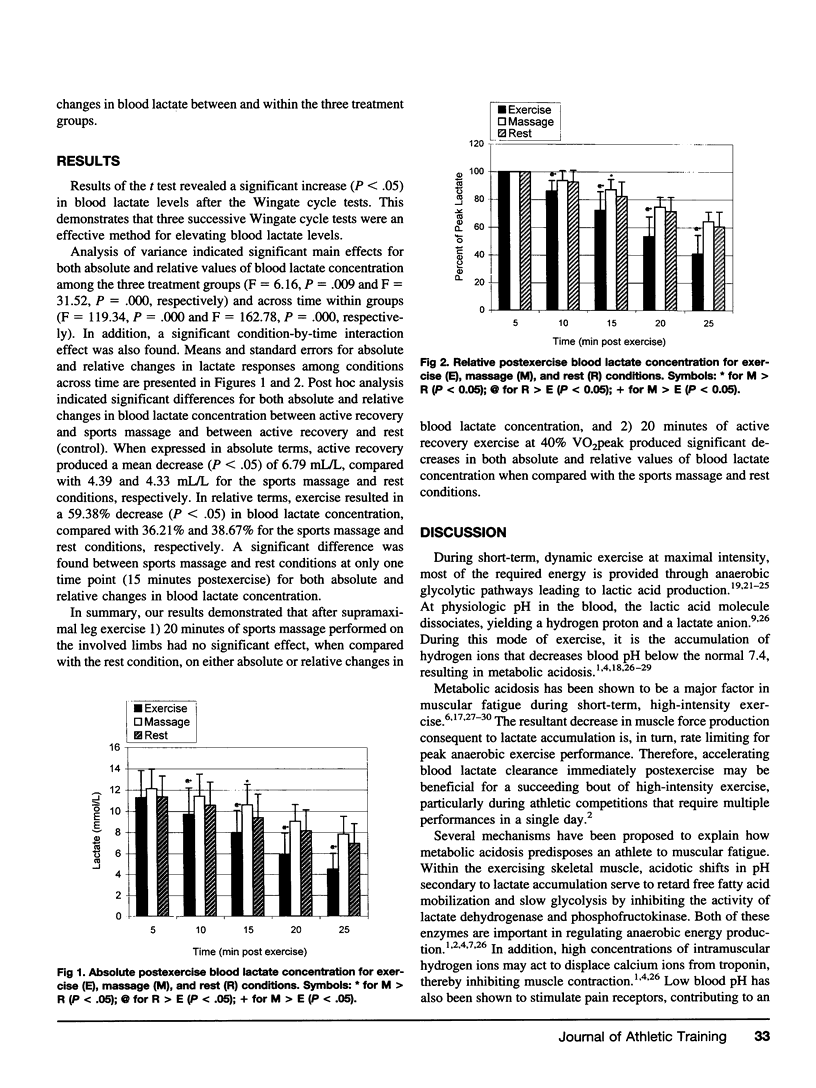
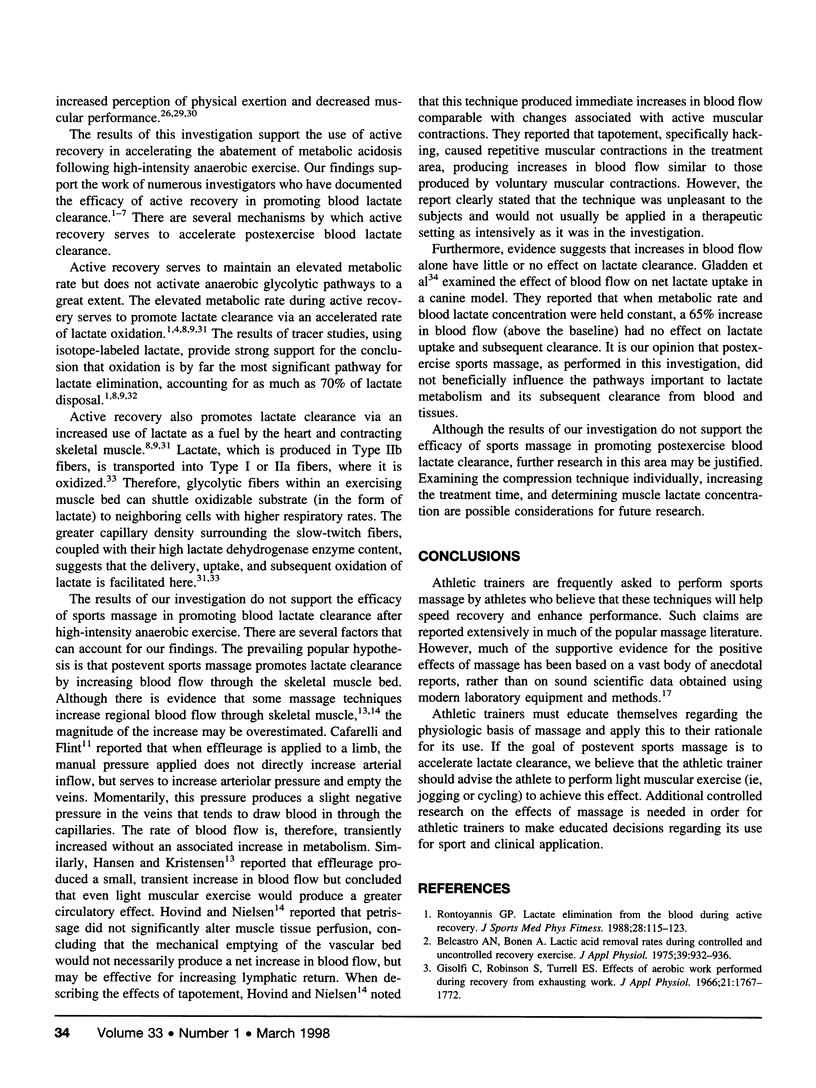
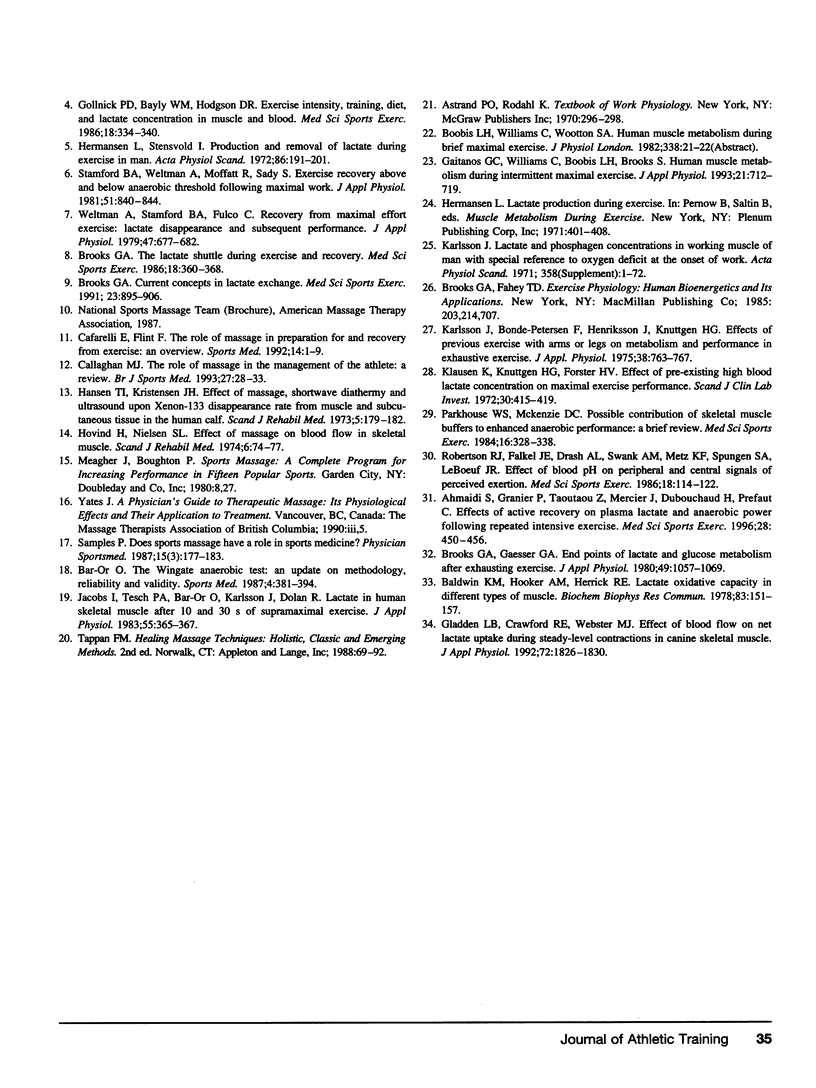
Selected References
These references are in PubMed. This may not be the complete list of references from this article.
- Ahmaidi S., Granier P., Taoutaou Z., Mercier J., Dubouchaud H., Prefaut C. Effects of active recovery on plasma lactate and anaerobic power following repeated intensive exercise. Med Sci Sports Exerc. 1996 Apr;28(4):450–456. doi: 10.1097/00005768-199604000-00009. [DOI] [PubMed] [Google Scholar]
- Baldwin K. M., Hooker A. M., Herrick R. E. Lactate oxidative capacity in different types of muscle. Biochem Biophys Res Commun. 1978 Jul 14;83(1):151–157. doi: 10.1016/0006-291x(78)90410-2. [DOI] [PubMed] [Google Scholar]
- Bar-Or O. The Wingate anaerobic test. An update on methodology, reliability and validity. Sports Med. 1987 Nov-Dec;4(6):381–394. doi: 10.2165/00007256-198704060-00001. [DOI] [PubMed] [Google Scholar]
- Belcastro A. N., Bonen A. Lactic acid removal rates during controlled and uncontrolled recovery exercise. J Appl Physiol. 1975 Dec;39(6):932–936. doi: 10.1152/jappl.1975.39.6.932. [DOI] [PubMed] [Google Scholar]
- Brooks G. A. Current concepts in lactate exchange. Med Sci Sports Exerc. 1991 Aug;23(8):895–906. [PubMed] [Google Scholar]
- Brooks G. A., Gaesser G. A. End points of lactate and glucose metabolism after exhausting exercise. J Appl Physiol Respir Environ Exerc Physiol. 1980 Dec;49(6):1057–1069. doi: 10.1152/jappl.1980.49.6.1057. [DOI] [PubMed] [Google Scholar]
- Brooks G. A. The lactate shuttle during exercise and recovery. Med Sci Sports Exerc. 1986 Jun;18(3):360–368. doi: 10.1249/00005768-198606000-00019. [DOI] [PubMed] [Google Scholar]
- Cafarelli E., Flint F. The role of massage in preparation for and recovery from exercise. An overview. Sports Med. 1992 Jul;14(1):1–9. doi: 10.2165/00007256-199214010-00001. [DOI] [PubMed] [Google Scholar]
- Callaghan M. J. The role of massage in the management of the athlete: a review. Br J Sports Med. 1993 Mar;27(1):28–33. doi: 10.1136/bjsm.27.1.28. [DOI] [PMC free article] [PubMed] [Google Scholar]
- Gaitanos G. C., Williams C., Boobis L. H., Brooks S. Human muscle metabolism during intermittent maximal exercise. J Appl Physiol (1985) 1993 Aug;75(2):712–719. doi: 10.1152/jappl.1993.75.2.712. [DOI] [PubMed] [Google Scholar]
- Gisolfi C., Robinson S., Turrell E. S. Effects of aerobic work performed during recovery from exhausting work. J Appl Physiol. 1966 Nov;21(6):1767–1772. doi: 10.1152/jappl.1966.21.6.1767. [DOI] [PubMed] [Google Scholar]
- Gladden L. B., Crawford R. E., Webster M. J. Effect of blood flow on net lactate uptake during steady-level contractions in canine skeletal muscle. J Appl Physiol (1985) 1992 May;72(5):1826–1830. doi: 10.1152/jappl.1992.72.5.1826. [DOI] [PubMed] [Google Scholar]
- Gollnick P. D., Bayly W. M., Hodgson D. R. Exercise intensity, training, diet, and lactate concentration in muscle and blood. Med Sci Sports Exerc. 1986 Jun;18(3):334–340. doi: 10.1249/00005768-198606000-00015. [DOI] [PubMed] [Google Scholar]
- Hansen T. I., Kristensen J. H. Effect of massage, shortwave diathermy and ultrasound upon 133Xe disappearance rate from muscle and subcutaneous tissue in the human calf. Scand J Rehabil Med. 1973;5(4):179–182. [PubMed] [Google Scholar]
- Hermansen L., Stensvold I. Production and removal of lactate during exercise in man. Acta Physiol Scand. 1972 Oct;86(2):191–201. doi: 10.1111/j.1748-1716.1972.tb05325.x. [DOI] [PubMed] [Google Scholar]
- Hovind H., Nielsen S. L. Effect of massage on blood flow in skeletal muscle. Scand J Rehabil Med. 1974;6(2):74–77. [PubMed] [Google Scholar]
- Jacobs I., Tesch P. A., Bar-Or O., Karlsson J., Dotan R. Lactate in human skeletal muscle after 10 and 30 s of supramaximal exercise. J Appl Physiol Respir Environ Exerc Physiol. 1983 Aug;55(2):365–367. doi: 10.1152/jappl.1983.55.2.365. [DOI] [PubMed] [Google Scholar]
- Karlsson J., Bonde-Petersen F., Henriksson J., Knuttgen H. G. Effects of previous exercise with arms or legs on metabolism and performance in exhaustive exercise. J Appl Physiol. 1975 May;38(5):763–767. doi: 10.1152/jappl.1975.38.5.763. [DOI] [PubMed] [Google Scholar]
- Karlsson J. Lactate and phosphagen concentrations in working muscle of man with special reference to oxygen deficit at the onset of work. Acta Physiol Scand Suppl. 1971;358:1–72. [PubMed] [Google Scholar]
- Klausen K., Knuttgen H. G., Forster H. V. Effect of pre-existing high blood lactate concentration on maximal exercise performance. Scand J Clin Lab Invest. 1972 Dec;30(4):415–419. doi: 10.3109/00365517209080279. [DOI] [PubMed] [Google Scholar]
- Parkhouse W. S., McKenzie D. C. Possible contribution of skeletal muscle buffers to enhanced anaerobic performance: a brief review. Med Sci Sports Exerc. 1984 Aug;16(4):328–338. [PubMed] [Google Scholar]
- Robertson R. J., Falkel J. E., Drash A. L., Swank A. M., Metz K. F., Spungen S. A., LeBoeuf J. R. Effect of blood pH on peripheral and central signals of perceived exertion. Med Sci Sports Exerc. 1986 Feb;18(1):114–122. [PubMed] [Google Scholar]
- Rontoyannis G. P. Lactate elimination from the blood during active recovery. J Sports Med Phys Fitness. 1988 Jun;28(2):115–123. [PubMed] [Google Scholar]
- Stamford B. A., Weltman A., Moffatt R., Sady S. Exercise recovery above and below anaerobic threshold following maximal work. J Appl Physiol Respir Environ Exerc Physiol. 1981 Oct;51(4):840–844. doi: 10.1152/jappl.1981.51.4.840. [DOI] [PubMed] [Google Scholar]
- Weltman A., Stamford B. A., Fulco C. Recovery from maximal effort exercise: lactate disappearance and subsequent performance. J Appl Physiol Respir Environ Exerc Physiol. 1979 Oct;47(4):677–682. doi: 10.1152/jappl.1979.47.4.677. [DOI] [PubMed] [Google Scholar]


